Quantitative Evaluation of Spatial Differentiation for Public Open Spaces in Urban Built-Up Areas by Assessing SDG 11.7: A Case of Deqing County
Abstract
:1. Introduction
2. Materials and Methods
2.1. Study Area and Data
2.2. Methods
2.2.1. Global Spatial Autocorrelation Analysis
2.2.2. Local Spatial Autocorrelation Analysis
2.2.3. Hot Spot Analysis
2.2.4. Statistics and Evaluation Methods of Urban Public Open Spaces by SDG 11.7
2.2.5. Geographically Weighted Regression Model
3. Results
3.1. Analysis of Global Differentiation Pattern
3.2. Analysis of Local Differentiation Pattern
3.3. Correlation Analysis between Population and Public Open Spaces
4. Discussion
4.1. Understanding Global and Local Spatial Pattern of Urban Public Open Spaces
4.2. Assessment of Urban Public Open Spaces by SDG 11.7.1
4.3. The Relationship between Population Agglomeration and the Types of Public Open Spaces
5. Conclusions
Author Contributions
Funding
Acknowledgments
Conflicts of Interest
References
- Chen, J.; Ren, H.; Geng, W.; Peng, S.; Fanghong, Y.E. Quantitative measurement and monitoring sustainable development goals (SDGs) with geospatial information. Geomat. World 2018, 25, 1–7. [Google Scholar]
- Liu, S.; Bai, J.; Chen, J. Measuring SDG 15 at the county scale: Localization and practice of SDGs indicators based on geospatial information. Int. J. Geo Inf. 2019, 8, 515. [Google Scholar] [CrossRef] [Green Version]
- Jalaladdini, S.; Oktay, D. Urban public spaces and vitality: A socio-spatial analysis in the streets of cypriot towns. Procedia Soc. Behav. Sci. 2012, 35, 664–674. [Google Scholar] [CrossRef] [Green Version]
- Xin, F. Construction of urban community public space under the view of “three governance integration”—Based on the exploration of d community in Shanghai. J. Soc. Sci. 2018, 3, 21–28. [Google Scholar]
- Luo, S.; Zhen, F. How to evaluate public space vitality based on mobile phone data:An empirical analysis of Nanjing’s parks. Geogr. Res. 2019, 38, 1594–1608. [Google Scholar]
- Pietrzyk-Kaszyńska, A.; Czepkiewicz, M.; Kronenberg, J. Eliciting non-monetary values of formal and informal urban green spaces using public participation GIS. Landsc. Urban Plan. 2017, 160, 85–95. [Google Scholar] [CrossRef]
- Xu, L. A review of urban public space research in contemporary China from a sociological perspective. Theory Mod. 2017, 6, 122–128. [Google Scholar]
- Yu, L.I.; Zhu, W. An introduction of active design guidelines: Promoting physical activity and health in design of New York city and thinking of urban sapce in Beijing city. World Archit. 2013, 9, 125–128. [Google Scholar]
- Nielsen, C.S. The democratic potential of artistic expression in public space: Street art and graffiti as rebellious acts. In Street Art of Resistance; Springer: Berlin/Heidelberg, Germany, 2017; pp. 301–323. [Google Scholar]
- Zhang, F.; Xiao, Y.; Yin, W.U. Spatial layout of public sports venues in urban communities—Based on yangpu district of Shanghai. J. Shanghai Univ. Sport 2014, 1, 80–83. [Google Scholar]
- Bahrini, F.; Bell, S.; Mokhtarzadeh, S. The relationship between the distribution and use patterns of parks and their spatial accessibility at the city level: A case study from Tehran, Iran. Urban For. Urban Green. 2017, 27. [Google Scholar] [CrossRef] [Green Version]
- Alessandro, R.; Matthew, B.; Viniece, J. Inequities in the quality of urban park systems: An environmental justice investigation of cities in the United States. Landsc. Urban Plan. 2018, 178, 156–169. [Google Scholar]
- Florindo, A.A.; Barrozo, L.V.; Cabral-Miranda, W.; Rodrigues, E.Q.; Turrell, G.; Goldbaum, M.; Cesar, C.L.G.; Giles-Corti, B. Public open spaces and leisure-time walking in Brazilian adults. Int. J. Environ. Res. Public Health 2017, 14, 553. [Google Scholar] [CrossRef] [PubMed] [Green Version]
- Sun, K.; De Coensel, B.; Filipan, K.; Aletta, F.; Van Renterghem, T.; De Pessemier, T.; Joseph, W.; Botteldooren, D. Classification of soundscapes of urban public open spaces. Landsc. Urban Plan. 2019, 189, 139–155. [Google Scholar] [CrossRef] [Green Version]
- Shirowzhan, S.; Lim, S.; Trinder, J. Enhanced autocorrelation-based algorithms for filtering airborne lidar data over urban areas. J. Surv. Eng. 2016, 142, 4015008. [Google Scholar] [CrossRef] [Green Version]
- Mohammad, A.A.; Reza, S.D.; Abdolreza, R.A.; Mohammadreza, R. Applying GIS to identify the spatial and temporal patterns of road accidents using spatial statistics (case study: Ilam Province, Iran). Transp. Res. Procedia 2017, 25, 2126–2138. [Google Scholar]
- Fan, C.; Myint, S. A comparison of spatial autocorrelation indices and landscape metrics in measuring urban landscape fragmentation. Landsc. Urban Plan. 2014, 121, 117–128. [Google Scholar] [CrossRef]
- Xia, C.; Anthony, G.-O.Y.; Zhang, A. Analyzing spatial relationships between urban land use intensity and urban vitality at street block level: A case study of five Chinese megacities. Landsc. Urban Plan. 2020, 193, 103669. [Google Scholar] [CrossRef]
- Shen, L.; Guo, X. Spatial quantification and pattern analysis of urban sustainability based on a subjectively weighted indicator model: A case study in the city of Saskatoon, SK, Canada. Appl. Geogr. 2014, 53, 117–127. [Google Scholar] [CrossRef]
- Majumdar, D.D.; Biswas, A. Quantifying land surface temperature change from LISA clusters: An alternative approach to identifying urban land use transformation. Landsc. Urban Plan. 2016, 153, 51–65. [Google Scholar] [CrossRef]
- Ginebreda, A.; Sabater-Liesa, L.; Rico, A.; Focks, A.; Barceló, D. Reconciling monitoring and modeling: An appraisal of river monitoring networks based on a spatial autocorrelation approach—emerging pollutants in the Danube River as a case study. Sci. Total Environ. 2018, 618, 323–335. [Google Scholar] [CrossRef]
- Ren, H.; Shang, Y.; Zhang, S. Measuring the spatiotemporal variations of vegetation net primary productivity in Inner Mongolia using spatial autocorrelation. Ecol. Indic. 2020, 112, 106108. [Google Scholar] [CrossRef]
- Li, R.; Chen, N.; Zhang, X.; Zeng, L.; Wang, X.; Tang, S.; Li, D.; Niyogi, D. Quantitative analysis of agricultural drought propagation process in the Yangtze River Basin by using cross wavelet analysis and spatial autocorrelation. Agric. For. Meteorol. 2020, 280, 107809. [Google Scholar] [CrossRef]
- Tan, L.Y.; Li, Q.; Tan, L. Spatial statistics analysis of RJGDP fo Beijing Tianjin and Hebei based on R. J. North China Inst. Sci. Technol. 2015, 3, 105–110. [Google Scholar]
- Wang, W.; Chang, Y.; Wang, H. An application of the spatial autocorrelation method on the change of real estate prices in Taitung City. ISPRS Int. J. Geo Inf. 2019, 8, 249. [Google Scholar] [CrossRef] [Green Version]
- Blazquez, C.A.; Picarte, B.; Calderón, J.F.; Losada, F. Spatial autocorrelation analysis of cargo trucks on highway crashes in Chile. Accid. Anal. Prev. 2018, 120, 195–210. [Google Scholar] [CrossRef] [PubMed]
- Chen, Y. New approaches for calculating Moran’s index of spatial autocorrelation. PLoS ONE 2013, 8, e68336. [Google Scholar] [CrossRef] [Green Version]
- Waldhör, T. The spatial autocorrelation coefficient Moran’s I under heteroscedasticity. Stat. Med. 1996, 15, 887–892. [Google Scholar] [CrossRef]
- Anselin, L. Local indicators of spatial association—LISA. Geogr. Anal. 1995, 27, 93–115. [Google Scholar] [CrossRef]
- Kondo, K. Hot and cold spot analysis using Stata. Stata J. 2016, 16, 613–631. [Google Scholar] [CrossRef] [Green Version]
- Prasannakumar, V.; Vijith, H.; Charutha, R.; Geetha, N. Spatio-temporal clustering of road accidents: GIS based analysis and assessment. Procedia Soc. Behav. Sci. 2011, 21, 317–325. [Google Scholar] [CrossRef] [Green Version]
- Wheeler, D.C.; Páez, A. Geographically weighted regression. In Handbook of Applied Spatial Analysis; Springer: Berlin/Heidelberg, Germany, 2010; pp. 461–486. [Google Scholar]
- Dong, N.; Yang, X.; Huang, D.; Han, D. Spatialization method of demographic data based on urban public facility elements. J. Geo Inf. Sci. 2018, 20, 918–928. [Google Scholar]
- Gao, J.; Fu, J.; Ye, C. Spatial characteristics and causes of urban public service facilities in Guangzhou city. Areal Res. Dev. 2012, 31, 71–75. [Google Scholar]
- Cybriwsky, R. Changing patterns of urban public space: Observations and assessments from the Tokyo and New York metropolitan areas. Cities 1999, 16, 223–231. [Google Scholar] [CrossRef]
- Johnson, A.J.; Glover, T.D. Understanding urban public space in a leisure context. Leis. Sci. 2013, 35, 190–197. [Google Scholar] [CrossRef]
- Mitchell, D. Introduction: Public space and the city. Urban Geogr. 1996, 17, 127–131. [Google Scholar] [CrossRef]
- Izzy, Y.J.; Luo, J.; Chan, E.H.W. Spatial justice in public open space planning: Accessibility and inclusivity. Habitat Int. 2020, 97, 102–122. [Google Scholar]
- Brunsdon, C.; Fotheringham, A.S.; Charlton, M. Some notes on parametric significance tests for geographically weighted regression. J. Reg. Sci. 1999, 39, 497–524. [Google Scholar] [CrossRef]
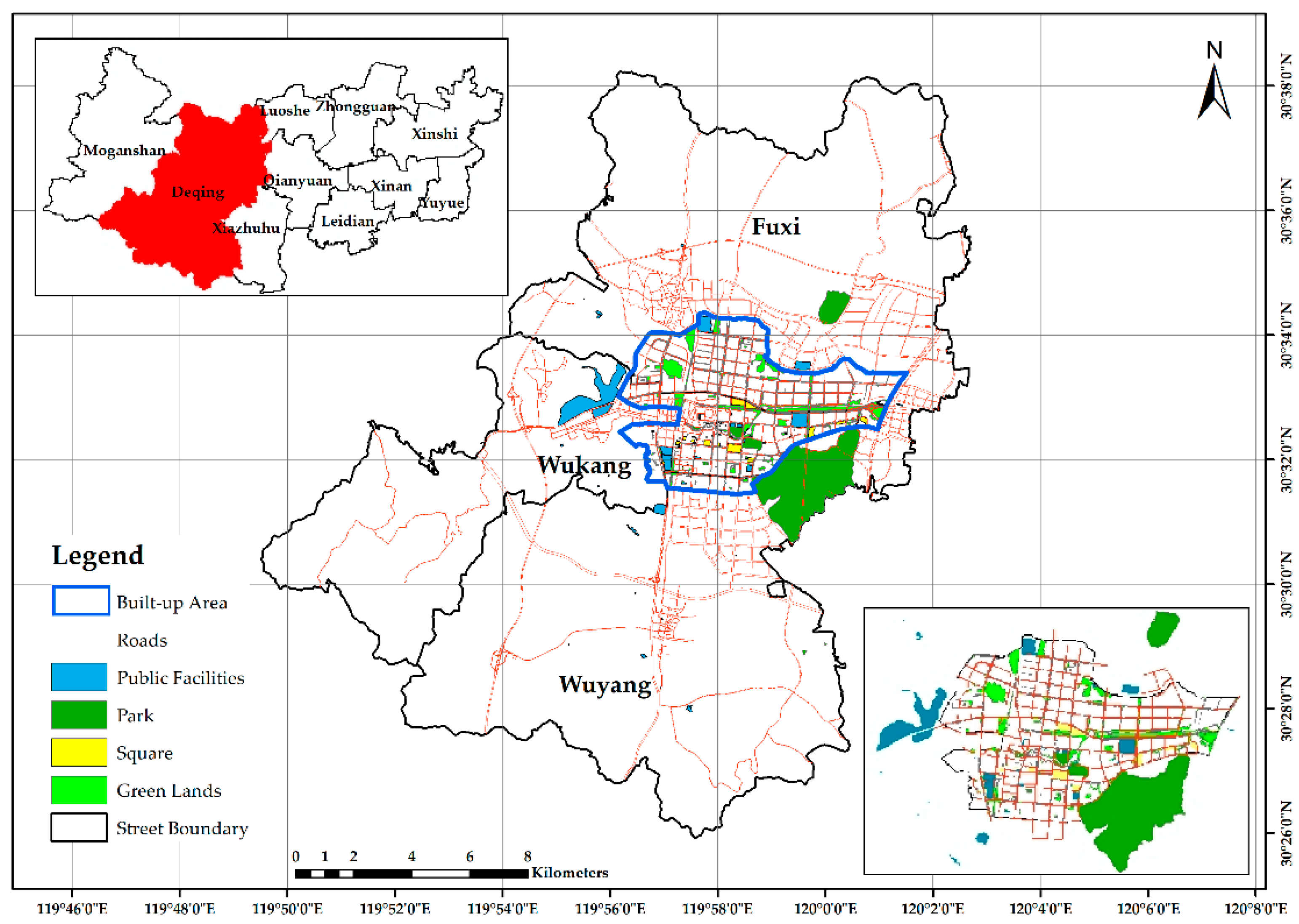
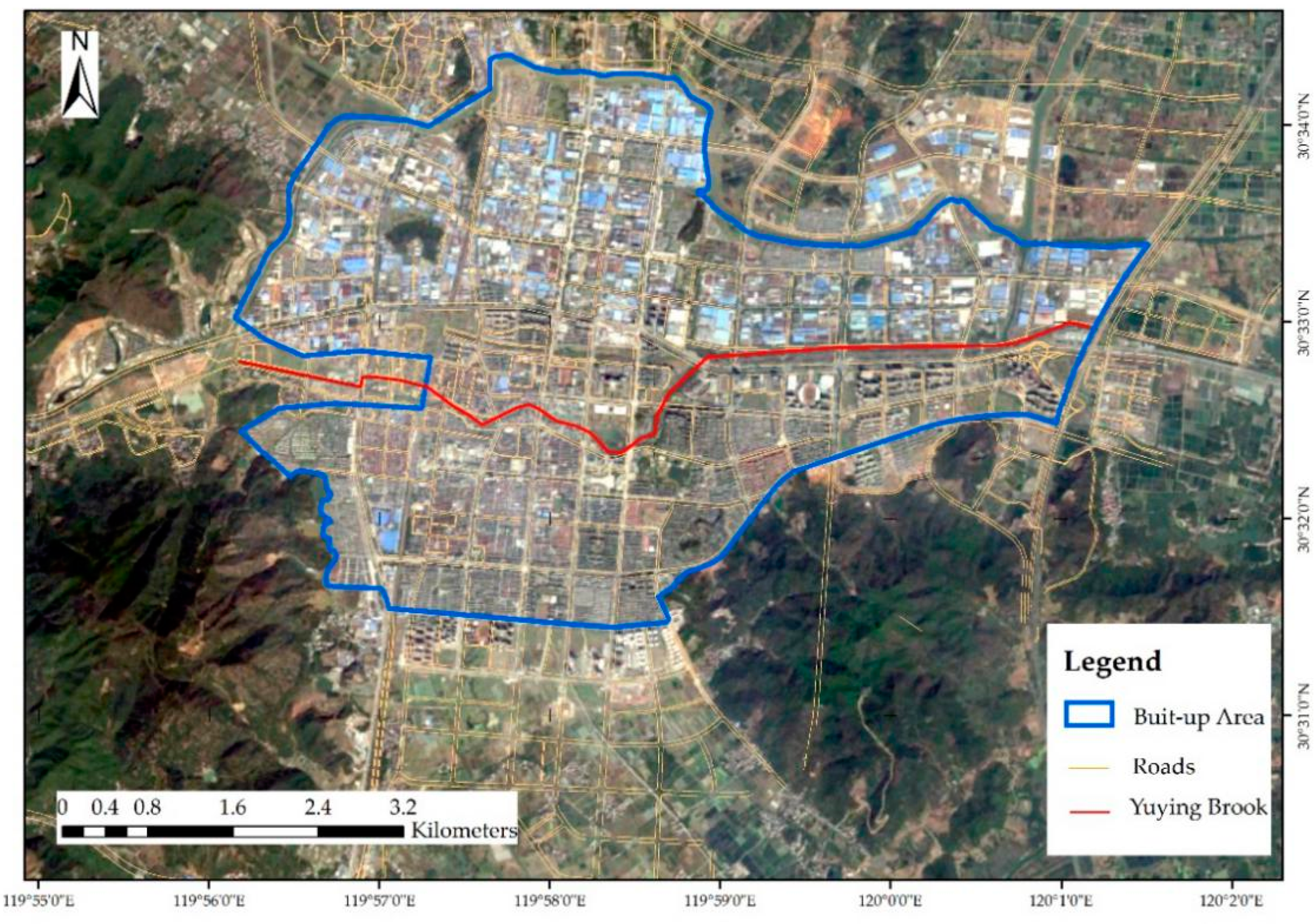
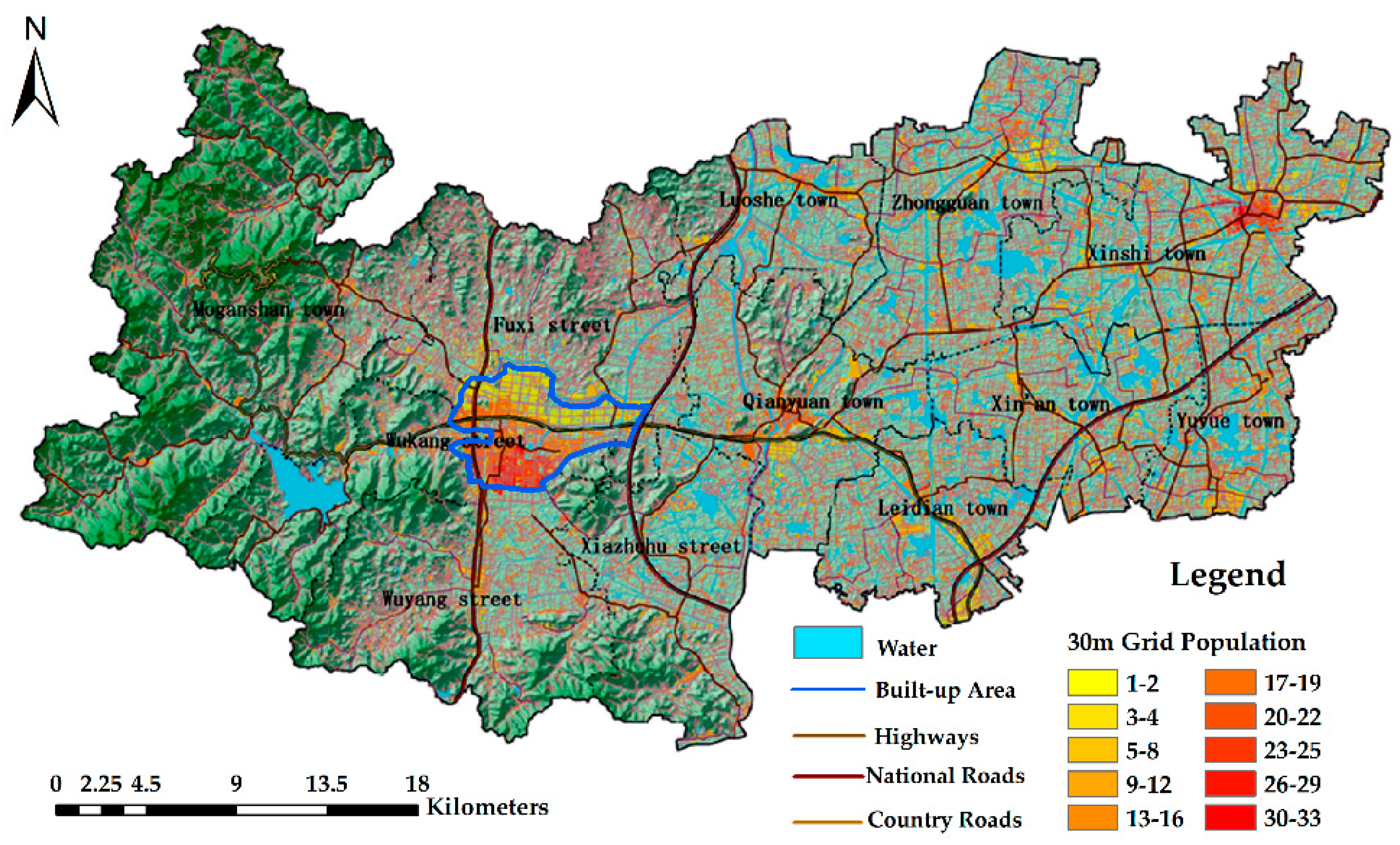
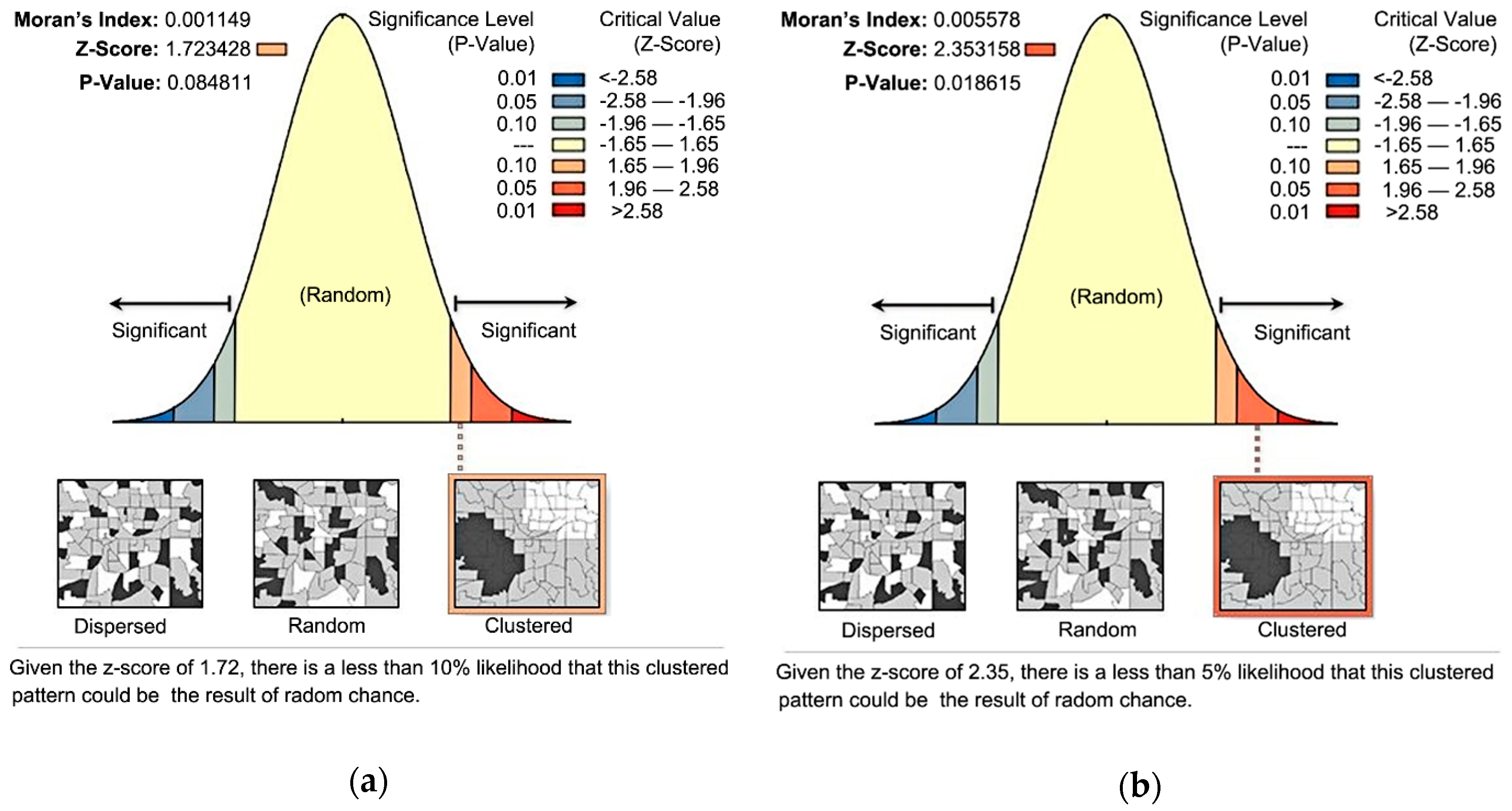



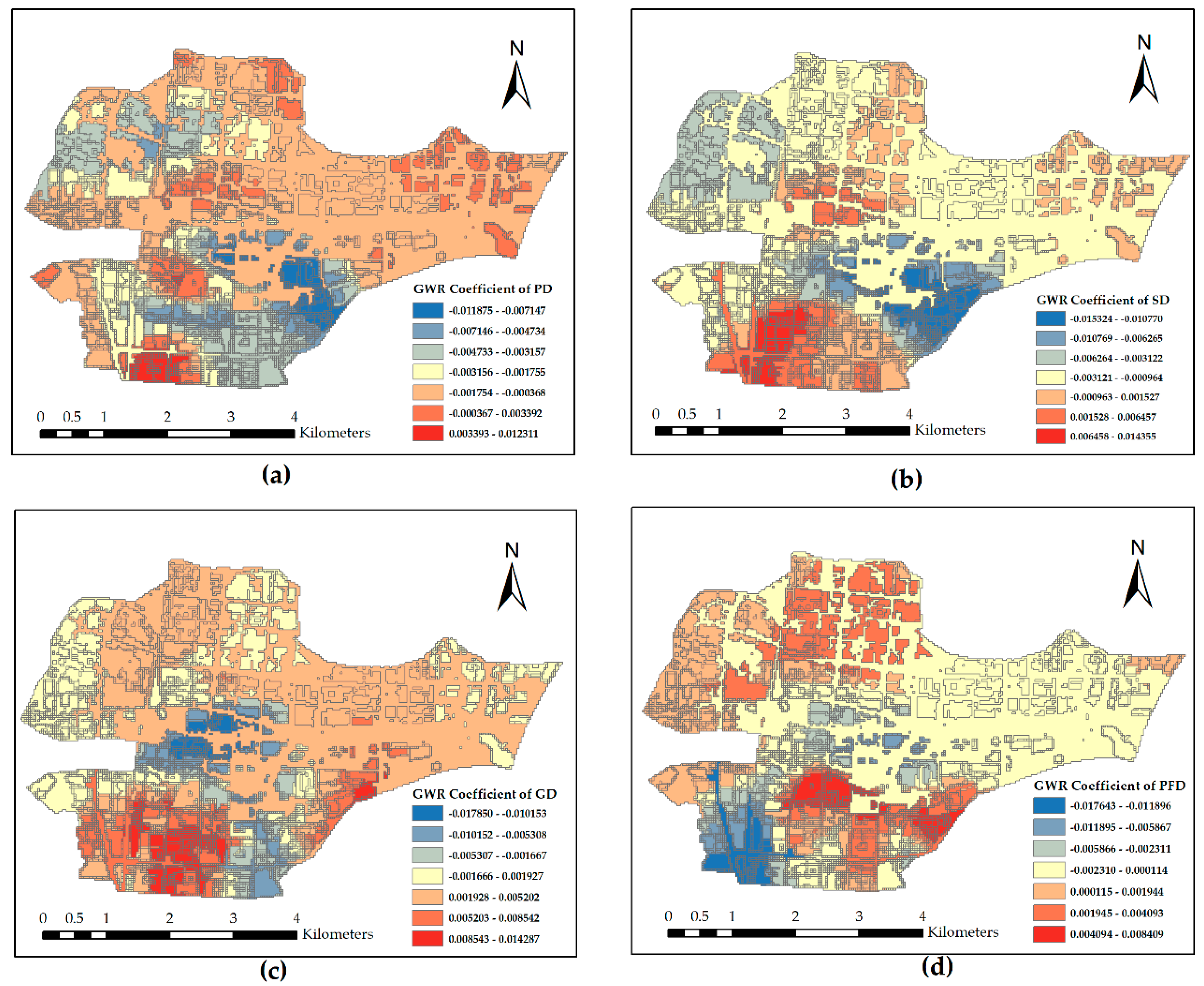
| Attributes | Area Range | Spatial Autocorrelation Analysis | ||
|---|---|---|---|---|
| Global Moran’I | Z-Score | p-Value | ||
| Area | Whole area | 0.001149 | 1.723 | 0.085 |
| Built-up area | 0.005578 | 2.353 | 0.018 | |
| Length | Whole area | 0.03332 | 13.05 | 0.0021 |
| Built-up area | 0.04647 | 17.117 | 0.0027 | |
| Type | Whole area | 0.13448 | 49.09 | 0.0000 |
| Built-up area | 0.1515 | 50.12 | 0.0000 | |
| Indicators | Deqing in 2016 | UN Goals in 2030 |
|---|---|---|
| Population | 440,000 | / |
| Built-up area (km2) | 34.64 | / |
| Area of public open spaces per capita (m2) | 8.63 | >1.5 |
| Proportion of total public open spaces (%) | 16.5 | 15 |
| Ratio of green lands (%) | 38 | 38.9 |
| Area of green lands per capita(m2) | 15.3 | 14.6 |
| Factors | Minimum | Upper Quartile | Median | Lower Quartile | Maximum | Mean | p-Value |
|---|---|---|---|---|---|---|---|
| Intercept | 1.403425 | 6.671395 | 8.59312 | 10.90685 | 15.17895 | 8.465096 | 0.3656 |
| PD | −0.01187 | −0.00398 | −0.00207 | −0.00088 | 0.012311 | −0.00231 | 0.5132 |
| SD | −0.01532 | −0.00384 | −0.00173 | 0.000458 | 0.014355 | −0.00205 | 0.2006 |
| GD | −0.01785 | −0.00122 | 0.00105 | 0.004885 | 0.014287 | 0.001162 | 0.3245 |
| PFD | −0.01764 | −0.00154 | 0.000483 | 0.001878 | 0.008409 | −0.00042 | 0.0115 |
© 2020 by the authors. Licensee MDPI, Basel, Switzerland. This article is an open access article distributed under the terms and conditions of the Creative Commons Attribution (CC BY) license (http://creativecommons.org/licenses/by/4.0/).
Share and Cite
Chen, Q.; Du, M.; Cheng, Q.; Jing, C. Quantitative Evaluation of Spatial Differentiation for Public Open Spaces in Urban Built-Up Areas by Assessing SDG 11.7: A Case of Deqing County. ISPRS Int. J. Geo-Inf. 2020, 9, 575. https://0-doi-org.brum.beds.ac.uk/10.3390/ijgi9100575
Chen Q, Du M, Cheng Q, Jing C. Quantitative Evaluation of Spatial Differentiation for Public Open Spaces in Urban Built-Up Areas by Assessing SDG 11.7: A Case of Deqing County. ISPRS International Journal of Geo-Information. 2020; 9(10):575. https://0-doi-org.brum.beds.ac.uk/10.3390/ijgi9100575
Chicago/Turabian StyleChen, Qiang, Mingyi Du, Qianhao Cheng, and Changfeng Jing. 2020. "Quantitative Evaluation of Spatial Differentiation for Public Open Spaces in Urban Built-Up Areas by Assessing SDG 11.7: A Case of Deqing County" ISPRS International Journal of Geo-Information 9, no. 10: 575. https://0-doi-org.brum.beds.ac.uk/10.3390/ijgi9100575






